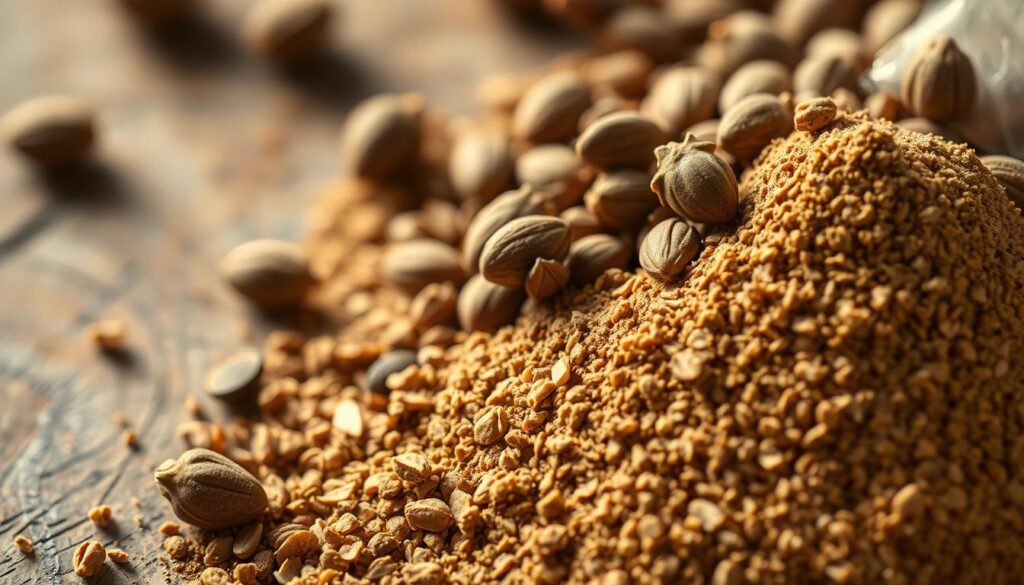Have you ever thought about how a small seed like cumin could change your health and cooking? Cumin, known as Cuminum cyminum, is more than just a spice. It’s packed with health benefits and adds flavor to food. It’s loved in many cuisines, like Mediterranean, Middle Eastern, and Indian.
As you learn about cumin, you’ll see its nutritional value. It’s full of antioxidants, helps with digestion, and might even fight inflammation. Are you ready to find out more about this amazing spice?
Key Takeaways
- Cumin contains powerful antioxidants and nutrients such as calcium, iron, and magnesium.
- Studies show cumin may aid in weight loss, improve insulin sensitivity, and lower cholesterol levels.
- It has carminative properties, helping alleviate digestive issues like gas and bloating.
- Cumin’s anti-inflammatory effects can promote better skin health and reduce inflammation.
- This spice is versatile in the kitchen, enriching various dishes across multiple cuisines.
What is Cumin?
Cumin is the dried seed of the Cuminum cyminum plant, part of the parsley family. It’s a spice used in many cuisines worldwide. The seeds are small, brown, and have a unique aroma. They are often confused with black cumin, but they are different.
There are two main types of cumin: whole seeds and ground powder. Each has its own uses in cooking. Cumin seeds have a warm, earthy flavor with a hint of citrus. This makes them a key ingredient in many dishes.
Whole cumin seeds can last up to two years if stored properly. Ground cumin, though, loses its flavor faster because of the loss of oils.
The cumin plant has been important in cooking for thousands of years. Its history goes back to ancient Syria and Egypt. Today, it’s a key spice in Indian, Mexican, and Tex-Mex cooking. It’s often mixed with spices like coriander and turmeric for a strong flavor.
Characteristics of Cumin Seeds
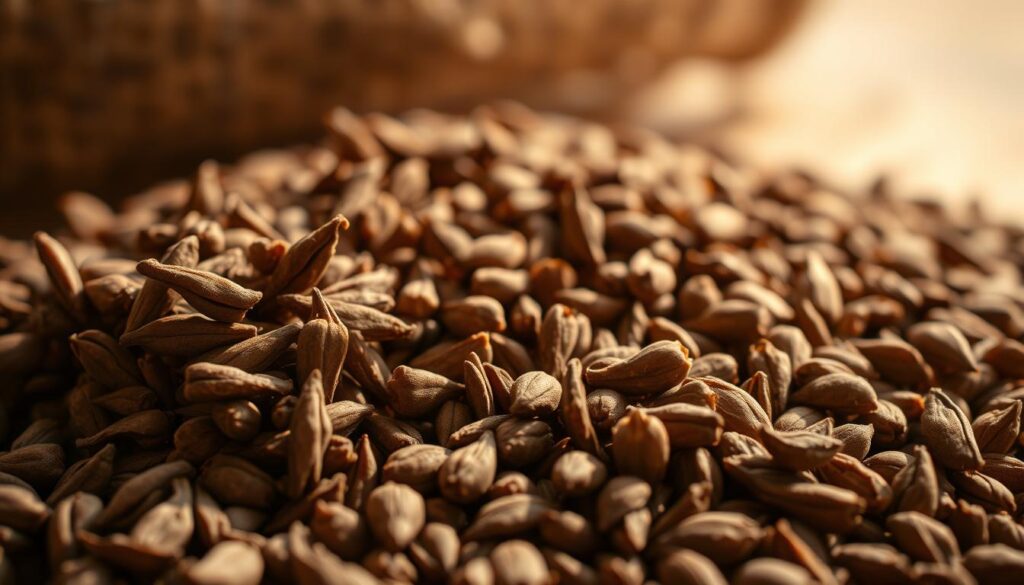
Cumin seeds are small and have ridged surfaces. They come from the Cuminum cyminum plant, part of the parsley family. Cumin is key in many cuisines, like Indian, Mexican, and Middle Eastern. It has a complex taste, with earthy, nutty, and slightly bitter notes, along with citrus undertones.
The aroma of cumin is strong, with earthy and smoky hints. Chefs love it for its ability to enhance savory dishes. It’s often used in curries, stews, and spice blends.
Toasting cumin seeds for 2-3 minutes boosts their flavor. Ground cumin is easier to use, helping absorb vitamins and minerals. Cumin’s versatility makes it a favorite worldwide, blending different flavors and textures.
Cumin: A Warm and Earthy Spice with Possible Benefits
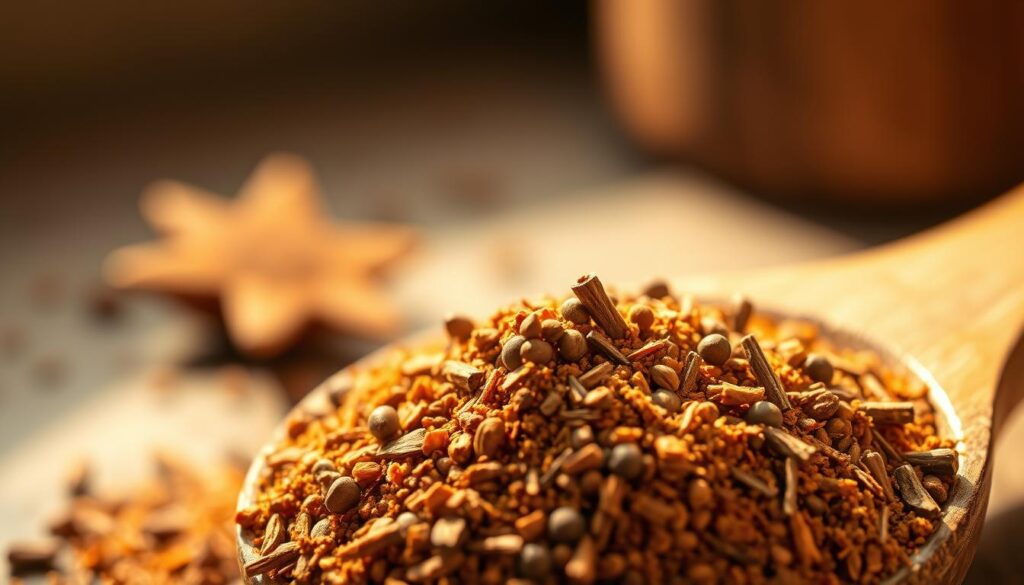
Cumin is known for its health benefits and role in many cuisines. People often talk about how it can help with digestion and reduce inflammation. This makes cumin more than just a flavor enhancer.
Health Benefits of Cumin
The health benefits of cumin are many. It’s good for your digestive health. Cumin seeds can help with bloating and indigestion. Adding cumin to your meals can improve digestion.
Rich in Antioxidants
Cumin is full of antioxidants. These help fight oxidative stress, which can lead to chronic diseases. Eating cumin regularly can reduce cell damage and lower disease risks. This keeps you healthier overall.
May Aid Digestion
Cumin is known for aiding digestion. In India, people chew cumin seeds after meals to help digestion. This shows how cumin is believed to support a healthy digestive system. Adding cumin to your meals can make digestion smoother.
Potential Anti-inflammatory Properties
Cumin has anti-inflammatory properties. It contains phytonutrients that fight inflammation. This can offer relief and improve your well-being. For those with chronic inflammation, cumin can be very helpful.
| Benefit | Description |
|---|---|
| Digestive Aid | Helps alleviate indigestion and bloating. |
| Antioxidant Properties | Reduces cellular damage; lowers chronic disease risk. |
| Anti-inflammatory | May reduce inflammation in chronic conditions. |
| Iron Content | Good source of iron; supports overall health. |
Using cumin in your cooking can bring out its best. It adds flavor and offers cumin health advantages. Whether you use whole seeds or ground cumin, it’s a valuable spice for health and taste.
Culinary Uses of Cumin
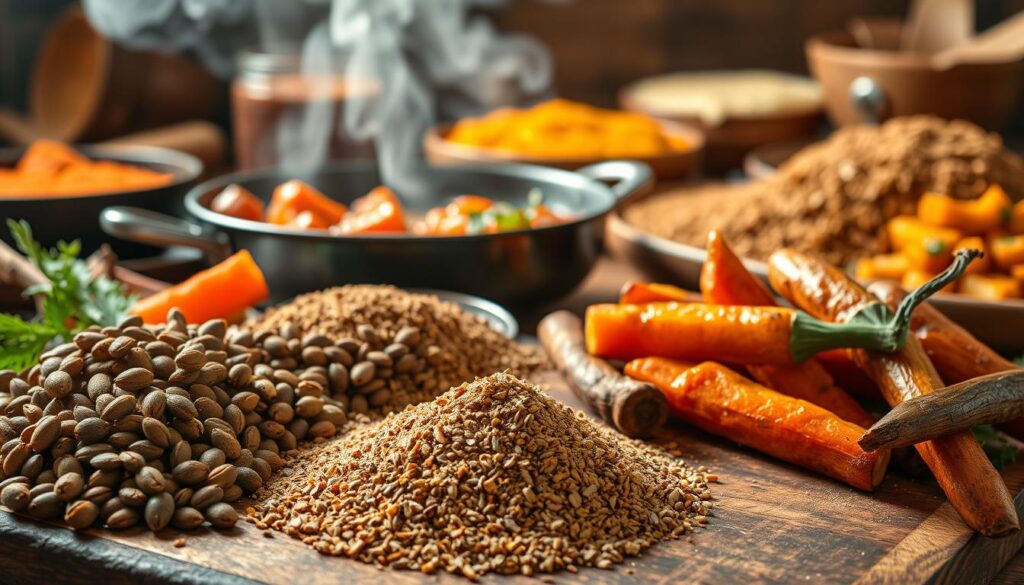
Cumin is a spice loved around the world for its unique taste and smell. It’s a key ingredient in many dishes, adding flavor. Its uses are found on every continent, making it a must-have in kitchens.
Common Cuisines Featuring Cumin
In Indian cooking, cumin pairs well with turmeric, adding depth and earthy notes. It’s a main ingredient in garam masala and jeera rice. In Mexican and Tex-Mex, cumin’s warmth is a key flavor, often mixed with coriander in chili con carne.
Middle Eastern and Mediterranean cooking also highlight cumin. It’s used in Moroccan Chicken Skewers, showing cumin’s power to boost flavors. Cumin can even add a surprising twist to some desserts.
Pairing Cumin with Other Spices
Cumin blends well with spices like garlic, chili powder, and paprika. This mix creates bold and complex flavors. Dry-roasting cumin seeds brings out a nutty, smoky taste, great in salads and yogurt.
Using whole seeds or ground cumin offers different benefits. Knowing how to mix cumin with other spices makes dishes aromatic and unforgettable.
Forms of Cumin: Whole Seeds vs. Ground Cumin
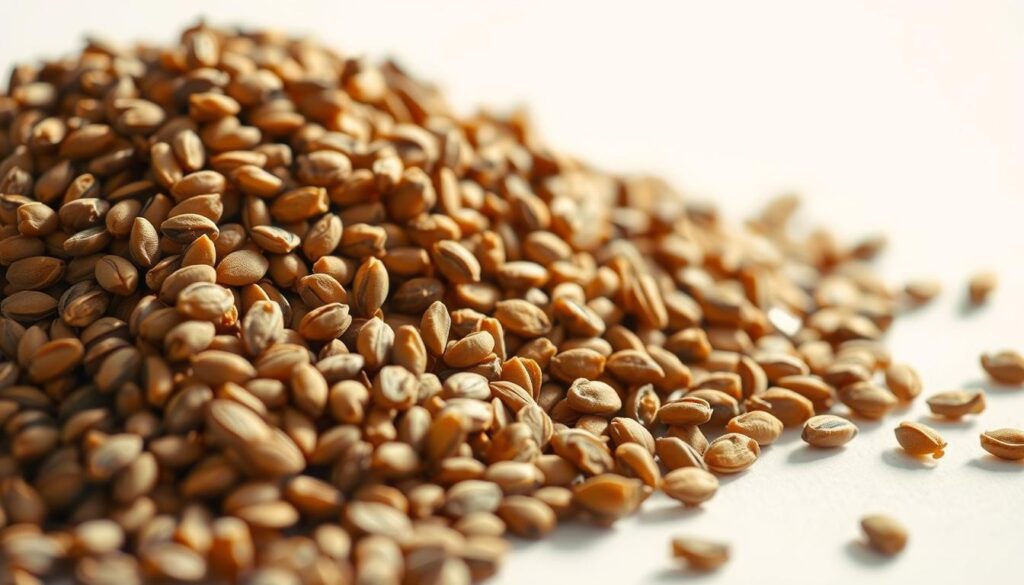
Cumin comes in two main forms: whole seeds and ground cumin. Each has its own taste and uses in cooking. Knowing the difference can make your cooking better. Whole cumin seeds have a stronger taste and can last up to two years if stored right.
Ground cumin, while flavorful, loses its taste faster, usually within six months to a year.
Storage and Shelf Life
Storing cumin correctly is key to keeping its flavor and quality. Here are tips for both forms:
- Whole cumin seeds should be in airtight containers to keep their taste for up to two years.
- Ground cumin is best used within six months to a year because it loses flavor quickly.
- Keep both forms in a cool, dark place, away from light and heat.
- Toasting whole cumin seeds before use can add a nutty, smoky flavor; aim for 2-3 minutes over medium heat.
- Ground cumin is convenient and adds flavor fast, but whole cumin seeds add texture and depth to dishes.
Having both whole cumin seeds and ground cumin in your pantry makes cooking more versatile. Your choice between them depends on the flavor you want in your dishes.
The History of Cumin and Its Cultural Significance

Cumin has a long and interesting history that goes back thousands of years. It started in the Middle East and soon spread to places like India, China, and the Mediterranean. Its journey shows how important cumin was to ancient cultures.
In ancient Egypt, cumin was used in mummification. This shows its big role in cultural practices and beliefs. It’s also key in Indian cuisine, being a main flavoring agent.
Cumin’s uses go beyond food, playing a role in traditional medicine and rituals. It’s even mentioned in the Bible, in Isaiah 28:25-27. This highlights its value and place in history.
Different cultures have used cumin in their cooking and medicine. It’s a key spice in many dishes, showing its value. Its history shows how cumin has shaped our taste and health practices.
How to Use Cumin in Cooking

Cumin is a versatile spice that can make your dishes taste amazing. It’s great for both taste and smell. From its rich history to its health benefits, cooking with cumin is worth trying.
Toasting Cumin Seeds for Enhanced Flavor
Toasting whole cumin seeds before using them can really boost their flavor. This method lets the seeds’ natural oils come out. This makes the spice more aromatic and strong.
Here’s a quick guide on how to toast cumin seeds:
- Heat a dry skillet over medium heat.
- Add the whole cumin seeds and toast them for 2-3 minutes, stirring frequently.
- Watch for a change in color and aroma; once fragrant and slightly darker, they’re ready.
- Remove from heat and let them cool before grinding or using whole.
This simple step can make cumin shine in many cuisines. It’s perfect for Mediterranean, Latin American, and Indian dishes. It adds warmth and earthiness to curries, stews, and spice blends.
Potential Side Effects of Cumin
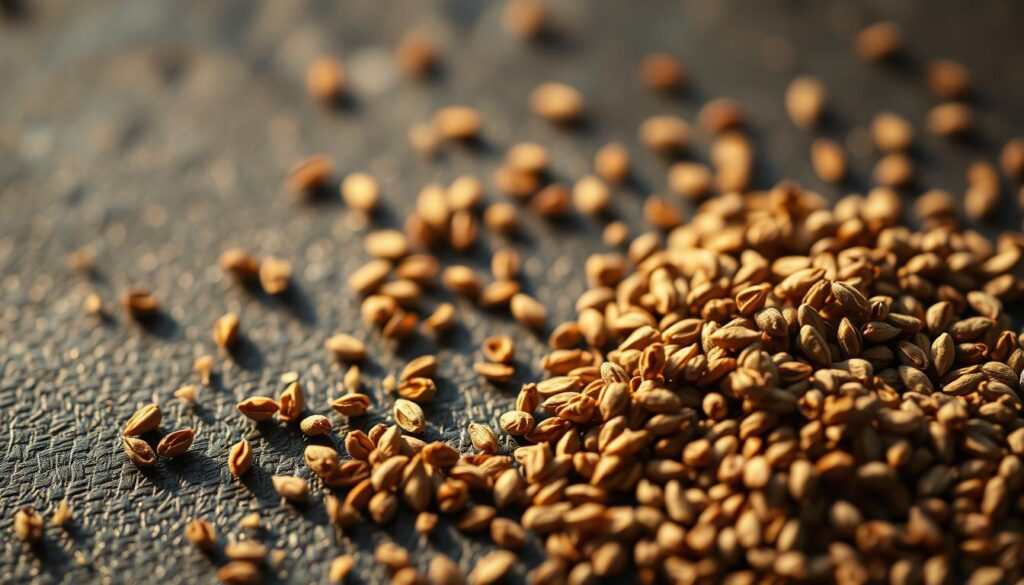
Cumin is known for its health benefits, like aiding digestion and having antioxidant properties. But, it’s key to know the possible cumin side effects and cumin health risks. Most people can safely eat cumin in small amounts. But, eating too much can cause stomach problems.
Cumin can cause serious allergic reactions in rare cases. About 1 in 5,000 to 1 in 10,000 people with food allergies might react. Also, 20% of those with spice allergies have had reactions to cumin. Workers in food processing might get skin reactions from cumin, affecting about 3% of them.
So, is cumin good for you? Yes, it is when eaten in normal amounts. It can help control blood sugar, aid in weight loss, and ease digestion. But, pregnant women and others should eat it in small amounts. High doses might lower testosterone, which could affect male fertility.
Conclusion
Cumin is more than just a tasty spice. It’s a nutritional powerhouse that boosts your health. It supports digestion and immune function, and may reduce inflammation in the gut. With 70 million Americans having digestive diseases, cumin can help a lot.
One teaspoon of cumin gives you about 20% of the daily iron you need. This is key for healthy blood. Studies also show cumin can help with Irritable Bowel Syndrome. So, adding cumin to your meals not only adds flavor but also health benefits.
Try using cumin in soups, teas, and more. It has a rich history and is culturally significant. Keep cumin in your kitchen to enjoy its many health and flavor benefits.

